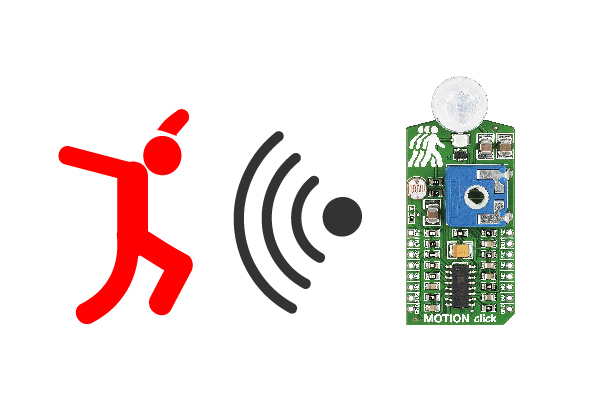OFF

MIKROE-1589
35 g
Status:
MOTION click is a motion detector sensitive only to live bodies. It carries PIR500B, a pyroelectric sensor. The click is designed to run on 3.3V power supply only. It communicates with the target MCU over RST and INT pin on the mikroBUS™ line.
This product is no longer in stock
Availability date:
MOTION click is a motion detector sensitive only to live bodies. It carries PIR500B, a pyroelectric sensor. The click is designed to run on 3.3V power supply only. It communicates with the target MCU over RST and INT pin on the mikroBUS™ line.

MOTION click carries PIR500B, a pyroelectric sensor which generates a voltage when exposed to infrared radiation emitted by live bodies (the white plastic Fresnel lens covering the sensor filters visible light).
The signal is processed by a BISS0001 PIR sensor controller which sends an interrupt to the MCU through the mikroBUS INT (out) line.
An onboard potentiometer lets you adjust the detecting range of the sensor (up to 1.7 meters).
The click also has a night only mode—resoldering a zero-ohm jumper activates the onboard photo resistor which acts as a light-sensitive switch.
You can also switch the sensor ON and OFF by sending a signal from the MCU through the mikroBUS RST pin.
MOTION click is ideal for alarm systems, light switch controllers, and similar systems where human presence needs to be detected.
| Type | Motion,Optical |
| Applications | Live body motion detection module based on pyroelectric sensor |
| On-board modules | PIR500B, a pyroelectric sensor , signal is processed by a BISS0001 PIR sensor controller |
| Key Features | Sensor which generates a voltage when exposed to infrared radiation emitted by live bodies |
| Interface | GPIO |
| Compatibility | mikroBUS |
| Click board size | L (57.15 x 25.4 mm) |
| Input Voltage | 3.3V,5V |
This table shows how the pinout on MOTION click corresponds to the pinout on the mikroBUS™ socket (the latter shown in the two middle columns).
Code examples for MOTION click, written for MikroElektronika hardware and compilers are available on Libstock.
This example initializes the sound port, enables the motion sensor and if activated, plays a tone.
01 void Tone1() 02 { 03 Sound_Play(659, 250); // Frequency = 659Hz, duration = 250ms 04 } 05 06 void Tone2() 07 { 08 Sound_Play(698, 250); // Frequency = 698Hz, duration = 250ms 09 } 10 11 void Tone3() 12 { 13 Sound_Play(784, 250); // Frequency = 784Hz, duration = 250ms 14 } 15 16 void main() 17 { 18 ANSELB = 0; // Configure PortB pins as digital 19 ANSELC = 0; // Configure PortD pins as digital 20 ANSELE = 0; // Configure PortE pins as digital 21 TRISB = 0x01; // Configure RB0 as output 22 TRISC = 0; // Set PortC as output 23 LATB = 0x00; // Reset PortB 24 25 Sound_Init(&PORTC, 2); // Initialization of sound port 26 27 PORTE.B1 = 1; // Enable Motion sensor 28 29 while(1) 30 { 31 if (PORTB.B0) 32 { // If sensor is activated 33 Tone1(); // Play tone 34 } 35 } 36 }
NOTE: Please be advised that any peripheral devices or accessories shown connected to the Click board™ are not included in the package. Check their availability in our shop or in the YMAN section below.